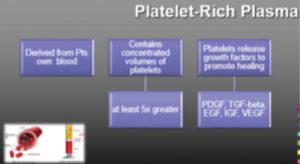

So what is PRP and how is it used?
PRP is prepared from taking a sample of your blood, then centrifuging it at varying speeds until the blood separates into 3 layers: platelet poor plasma (PPP), platelet rich plasma (PRP), and red blood cells. Usually 2 spins are used. The first spin separates the platelet poor plasma (PPP) from the red fraction and platelet rich plasma (PRP). The second spin separates the red fraction from the PRP. The material with the highest specific gravity (the PRP) will be at the bottom of the tube. The PRP is separated and will be used for treatment. Prior to the application of the PRP, a platelet activator/agonist (topical bovine thrombin) is added to activate the clotting cascade, producing a platelet gel. The process to prepare the PRP takes about 15 minutes and produces a concentration of platelets that is 3-5 times greater.
Platelets are important because they are a natural source of growth factors. The release of these growth factors is triggered by activating the clotting cascade/activating the platelets. Thrombin, calcium chloride or collagen all can be used to activate the platelets. Growth factors are important because they are critical to wound healing and regenerative processes. PRP has an increased concentration of these important growth factors. The doctor will than used this PRP (with a concentrated amount of growth factors) to inject the area of concern/area of pain. PRP can be used on arthritic joints, ligament damage and tendon injuries. Examples include: peroneal tendinitis, posterior tibial tendinitis, plantar fasciitis, ankle sprains, and Achilles tendon injuries. PRP is not used if there is a complete tear of a ligament or tendon. PRP can also be used to treat painful joints depending on the cause of the joint pain. Multiple treatments may or may not be required. Ultrasound guided injection is encouraged. Using an ultrasound ensures the PRP is injection in the exact area of pain/injury. Combining PRP with other treatments like physical therapy can also improve the effectiveness.
How to maximized effectiveness?
There are new studies that have emerged describing why the medical community may experience varying degrees of effectiveness with PRP. Studies have shown that there are many variables that can affect the quality of the growth factors that are released. Understanding these variable will allow your provider to maximize the effectiveness of your PRP treatment. There are 2 major variables that account for the observed difference in PRP efficacy. The first is the PRP composition- differs depending on the device used to prepare the PRP. The second variable is the method of PRP application. Consistent results will only be seen once these variables associated with PRP preparation and application are addressed. Other variables that need to be considered include: the physiological status of the patient, platelet activation method, and type of tissue and injury.
These variables determine if the platelets aggregate and release their growth factors at the pain site.
Understanding these variables and accounting for them prior to administration of PRP will result in optimal results with PRP treatment. It is also important to follow your provider’s guidelines following treatment to ensure optimal results.
To learn more about PRP and its application please contact your local foot and ankle specialist.
Isin Mustafa
DPM, MSHS, AACFAS
(833) 366-8534 (FOOT LEG)
www.NaplesPodiatrist.com
3161 Harbor Blvd, Suite B, Port Charlotte, FL 33952
For more information, you may contact Dr. Isin Mustafa at Family Foot & Leg Center at (833) 366-8534. Family Foot & Leg Center has 8 locations throughout Collier, Lee, & Charlotte Counties to quickly resolve all your foot and ankle problems.
Zhejiang Xingyue Biotechnology Co. L. Impact of Autologous Pure Platelet-rich Plasma in the Treatment of Tendon Disease. http://proxy.westernu.edu/login?url=http://search.ebscohost.com/
login.aspx?direct=true&db=edsclt&AN=edsclt.NCT03300531&site=
eds-live. Accessed February 19, 2019.
 Southwest Florida's Health and Wellness Magazine Health and Wellness Articles
Southwest Florida's Health and Wellness Magazine Health and Wellness Articles

